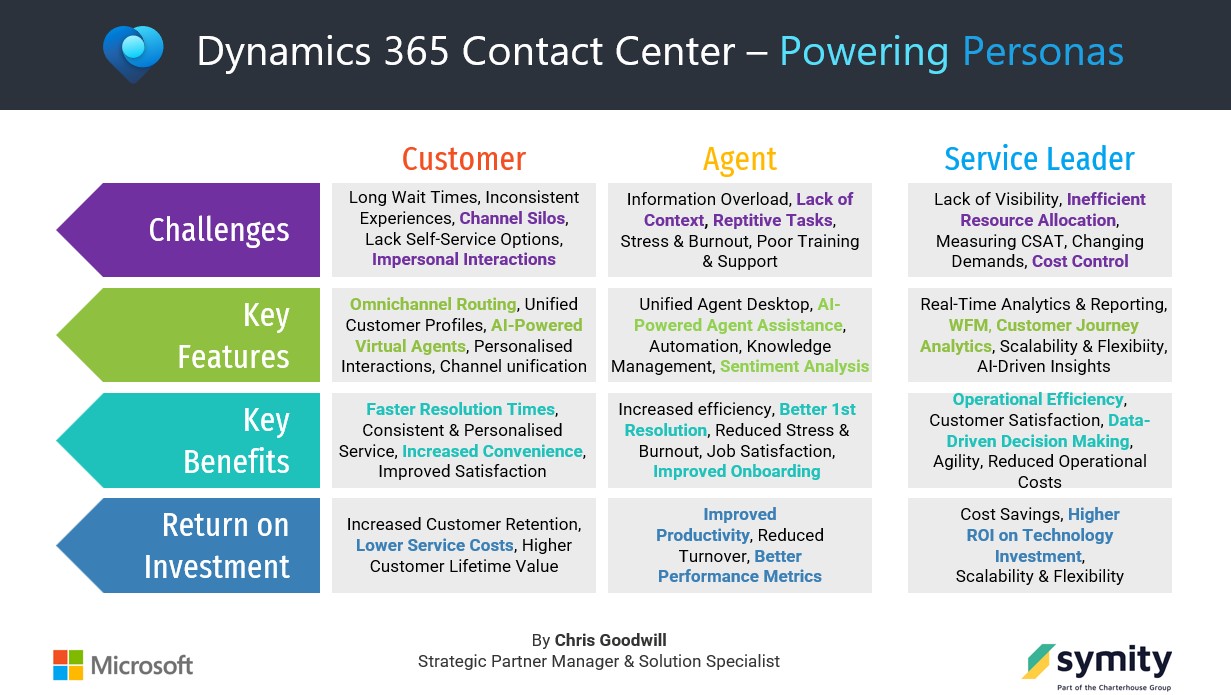Challenges, even in the operational segment of Customer Service can be broad and wide ranging. Specific challenges are faced by three key personas that can be a commonly found in service environments: actual customers, contact centre agents (or service representatives) and service leaders (e.g. contact centre managers, customer service directors).

These personas align with the central functional pillars from Microsoft’s go-to-market (GTM) as I see them of ‘Self-Service’, ‘Agent-Assist’ and ‘Operational Efficiency’. So I’m going to breakdown this article into the 3 key personas, outline the current challenges, how Dynamics 365 Contact Center as a Copilot first contact centre can help meet those challenges, followed by the key benefits of the CCaaS platform for that persona and finishing with a call out of return on investment (ROI) for the role.
1. Customers
Challenges:
– Long Wait Times: Frustration with lengthy hold times and delays in getting assistance.
– Inconsistent Experiences: Dealing with different agents who provide varying levels of service and knowledge.
– Channel Silos: Having to repeat information when switching between channels (phone, chat, email).
– Lack of Self-Service Options: Difficulty finding quick answers to simple questions without agent interaction.
– Impersonal Interactions: Feeling like just another number, with little or no personalised service.
Dynamics 365 Contact Center Features Addressing Challenges:
– Omnichannel Routing: Intelligent routing directs customers to the most appropriate agent based on skills and availability, minimising wait times.
– Unified Customer Profiles: Provides agents with a 360-degree view of the customer’s history and interactions, ensuring consistent and informed service.
– AI-Powered Virtual Agents: Enables self-service options for common queries, reducing the need for agent interaction.
– Personalised Interactions: Leverages customer data to tailor interactions and provide relevant solutions.
– Channel Unification: Maintaining customer context across all channels.
Key Benefits:
– Faster Resolution Times: Reduced wait times and efficient routing lead to quicker problem resolution.
– Consistent and Personalised Service: A unified customer view and AI-driven insights ensure a more personalised and consistent experience.
– Increased Convenience: Self-service options and omnichannel support provide greater flexibility and convenience.
– Improved Satisfaction: Overall, customers experience less frustration and higher satisfaction with the contact centre.
Return on Investment:
– Increased Customer Retention: Improved service quality and customer satisfaction lead to higher customer loyalty and retention rates.
– Lower Service Costs: Efficient self-service options and faster issue resolution reduce the overall cost of service delivery for customers.
– Higher Customer Lifetime Value: Satisfied customers are more likely to engage in repeat business and recommend the organisation to others, increasing their lifetime value.
2. Agents
Challenges:
– Information Overload: Struggling to access and manage information from disparate systems.
– Lack of Context: Difficulty understanding the customer’s history and needs, leading to inefficient interactions.
– Repetitive Tasks: Spending excessive time on manual and repetitive tasks.
– Stress and Burnout: Dealing with frustrated customers and complex issues can lead to high stress levels.
– Poor Training and Support: Inadequate training and lack of real-time assistance hinder their ability to provide effective service.
Dynamics 365 Contact Center Features Addressing Challenges:
– Unified Agent Desktop: Provides a single, integrated workspace with access to all relevant information and tools.
– AI-Powered Agent Assistance: Offers real-time suggestions and guidance, helping agents resolve issues quickly and accurately.
– Automation: Automates repetitive tasks, freeing up agents to focus on more complex and valuable interactions.
– Knowledge Management: Provides easy access to a centralised knowledge base, enabling agents to find answers quickly.
– Sentiment Analysis: Provides agents with real-time customer sentiment to help guide the conversation.
Key Benefits:
– Increased Efficiency: Streamlined workflows and automation enable agents to handle more interactions in less time.
– Improved First-Call Resolution: Access to comprehensive information and AI-powered assistance leads to faster and more accurate resolutions.
– Reduced Stress and Burnout: Automation and improved tools alleviate the burden of repetitive tasks and complex issues.
– Enhanced Job Satisfaction: Agents feel more empowered and effective, leading to higher job satisfaction.
– Improved Training and Onboarding: Faster onboarding and more effective real-time assistance.
Return on Investment:
– Improved Productivity: Automation and AI assistance enable agents to handle more interactions and resolve issues faster, increasing their productivity.
– Reduced Turnover: Enhanced job satisfaction and reduced stress levels lead to lower agent turnover rates, saving recruitment and training costs.
– Better Performance Metrics: Access to real-time guidance and comprehensive customer information helps agents meet and exceed performance targets.
3. Service Leaders
Challenges:
– Lack of Visibility: Difficulty tracking key performance indicators (KPIs) and understanding contact centre performance.
– Inefficient Resource Allocation: Struggling to optimise staffing levels and agent assignments.
– Difficulty Measuring Customer Satisfaction: Lack of real-time insights into customer sentiment and feedback.
– Inability to Adapt to Changing Demands: Difficulty scaling operations and responding to fluctuations in call volume.
– Controlling Costs: Finding ways to reduce operational costs while maintaining high levels of customer satisfaction.
Dynamics 365 Contact Center Features Addressing Challenges:
– Real-Time Analytics and Reporting: Provides comprehensive dashboards and reports for monitoring KPIs and identifying trends.
– Workforce Management: Enables efficient scheduling and resource allocation based on real-time demand.
– Customer Journey Analytics: Provides insights into customer interactions across all channels, enabling leaders to identify areas for improvement.
– Scalability and Flexibility: Cloud-based architecture allows for easy scaling of operations to meet changing demands.
– AI-Driven Insights: Provides insights into agent performance and customer pain points.
Key Benefits:
– Improved Operational Efficiency: Real-time analytics and workforce management enable leaders to optimise resource allocation and reduce costs.
– Enhanced Customer Satisfaction: Insights into customer sentiment and feedback enable leaders to identify and address areas for improvement.
– Data-Driven Decision Making: Comprehensive analytics and reporting provide the data needed to make informed decisions.
– Increased Agility: Scalable architecture and flexible tools enable leaders to adapt quickly to changing demands.
– Reduced Operational Costs: Through better resource management and automation.
Return on Investment:
– Cost Savings: Optimised resource allocation, reduced agent turnover, and efficient self-service options contribute to significant cost savings.
– Higher ROI on Technology Investment: The integration of AI and automation results in improved operational efficiency and better service outcomes, providing a higher return on investment.
– Scalability and Flexibility: The ability to scale operations and adapt to changing demands ensures that the contact centre can meet customer needs without excessive costs.
Conclusion
It’s clear that Microsoft’s Dynamics 365 Contact Center, with its comprehensive suite of features and AI-driven capabilities, is poised to revolutionise the customer service landscape. By addressing the unique challenges faced by customers, agents, and service leaders, this CCaaS platform will ensure that each persona experiences significant benefits, ranging from faster resolution times and personalised service to enhanced job satisfaction and operational efficiency.
Looking ahead, I believe (and I’m not alone here) that the future of customer service will be increasingly shaped by generative AI. As the technology continues to evolve, we can expect even greater advancements in the way contact centres operate. Generative AI will enable more sophisticated virtual agents, capable of understanding and responding to complex customer queries with high accuracy and empathy. This will reduce the burden on human agents, allowing them to focus on more strategic and value-driven interactions.
All I can say is, I believe it’s an exciting time to work on customer service and contact centre consultancy, similarly organisations have an opportunity here to drive customer service to new heights of satisfaction. This year will bring more Microsoft announcements I expect, so strap in and enjoy the journey we’re all embarking on now with Dynamics 365 Contact Center, could take us somewhere we didn’t expect in terms of customer experience excellence.
Get in touch with our Team today to find out how Symity can help you with this.
More in our CCaaS Hub.
